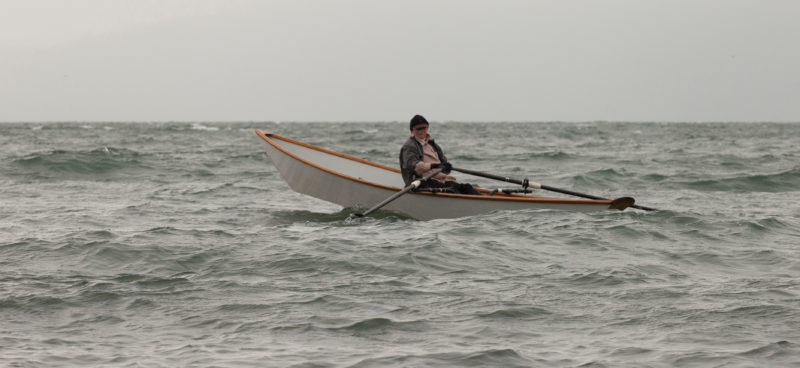 David Scherrer, www.scherrerphoto.com
David Scherrer, www.scherrerphoto.comAuthor Dale McKinnon, in her sliding-seat equipped light dory, makes her way upwind.
Sailors want wind; rowers don’t. Rough water can be a challenge to a rower’s skills, but I’ve found a few techniques that can help you reach a safe haven when conditions on the water take a turn for the worse.
I had the first difficult row of my wilderness-rowing career 10 years ago in Wright Sound, British Columbia. I was into the third week of rowing my 20′ dory from Ketchikan, Alaska, to Bellingham, Washington, a distance just shy of 800 miles. Halfway across the entrance to McKay Reach I encountered swirling gale-force winds and waves coming at me from all directions. As my fear increased, my grip on the oars grew tighter. I was tiring quickly and my hands, forearms, and back ached. I knew that if I didn’t regain my composure and relax, fatigue would add exponentially to the danger I was in. To reach the safety of even the nearest lee I would have to conserve energy. I kept pulling and calmed myself. I loosened my grip and soon felt my body begin to relax. As my spine became less stiff, my hips could adjust to the wild gyrations of the hull. My head no longer swayed with every wave, and my growing dizziness subsided. My blades stopped getting slapped skyward off the tops of waves, and my tendency to “catch a crab” disappeared. I could feel the water on each blade and adjust more quickly to the waves’ erratic shapes.
Shorten Your Stroke
In difficult seas you have control of the boat only when the blades of your oars are in the water. Many rowers believe, erroneously, that long, powerful strokes will get them through a clutch situation, but in a long pull, the blades are most effective in moving the boat forward through the middle 45 degrees of the blade’s arc. At the beginning and end of that arc they exert about as much outward or inward pressure as propulsive power. Long strokes also lengthen the time your blades are out of the water during the recovery and, if your boat is rocking, will have the oar handles flailing up and down during the pull. Shorten your stroke by a quarter to a half.
Relax
As the wind gets stronger and waves bigger, it’s natural to grip the oars more firmly, but tightness in your hands will have a domino effect of tension through your entire body; you’ll lose the ability to accommodate your pull to the changing contours of the waves. Relax. If your hands are resting lightly on the oar handles, most oars are balanced well enough for the blades, when squared, to find their perfect level just below the water’s surface. Gripping the oars for dear life stiffens your arms and will result in missed catches and washed-out finishes.
During the recovery phase of the stroke, a tight grip will likely force the blades to plow into waves. The handles, driven both downward and forward can knock you off balance or even shove you off your seat. Feather your blades: If you clip the top of a wave, the blade will skip over it.
During the drive phase, a perceived need to exert extra effort and control may compel you to dig the blades too deep. The lower the blades dive, the higher your arms and hands go, reducing the power you can apply, the effectiveness of the oar’s arc, and the ease with which you can release the blades at the end of the stroke.
If you concentrate on softening your grip, you will find that you will calm the rest of your body. Stay balanced and relaxed, and let the boat do its wild hokey-pokey beneath you; you’ll find that the water isn’t quite as rough as you thought.
Cross the Trough
Rowing with the wind and waves on the beam will tire you quickly, and having one oar blade sky and the other submerge is a sure way to lose your temper. Waves cresting against your flanks also increase the possibility of swamping. If the course to your nearest safe haven is across the wind, quarter your boat into the wind and waves. Not only will this counter the usual downwind set, it will also diminish your boat’s rolling and allow your oars to remain more balanced in relation to each other. If you work your way well upwind of your mark, turn to take the waves on the stern quarter. A zigzag course will avoid settling into the trough.
Avoidance
The best approach to rowing in uncomfortably rough water is, of course, not to, so listen to the marine forecasts. Meteorology is not an exact science: Allow for errors in the forecast and give yourself escape routes. Along inland waterways even accurate forecasts tell you only what’s going on in the big picture. You need to know how topography affects local winds and waves. Look in all directions for the telltales of wind in the sky and on the water’s surface. Under oars you’re aboard one of the least powerful vessels on the water, so noticing and understanding a catspaw or a sawtoothed horizon is critical. Pay attention, be flexible in your plans, and keep a relaxed hand on your oars.![]()
Dale McKinnon began rowing in 2002 at the age of 57 and in 2004 rowed solo from Ketchikan, Alaska, to Bellingham, Washington. In 2005 she rowed from Ketchikan to Juneau. The Salish Sea of Washington and British Columbia is her playground. She lives in Bellingham near her grandkids, with her partner Berns, and a chocolate Lab Thea, and builds Sam Devlin-designed Oarlings for other rowers.
You can share your tricks of the trade with other Small Boats Monthly readers by sending us an email.

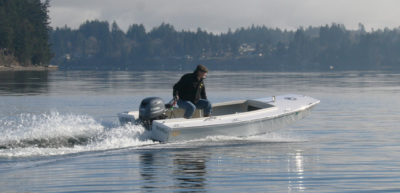
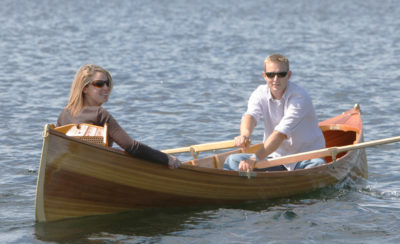
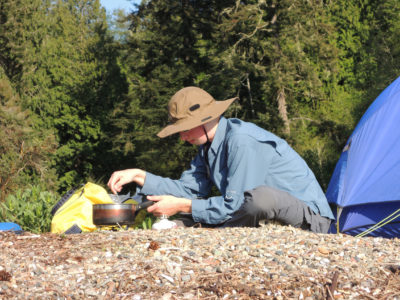
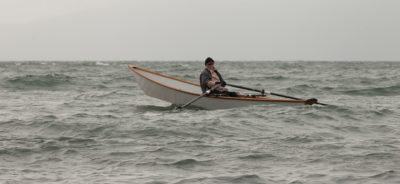
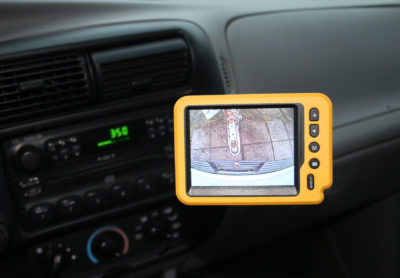
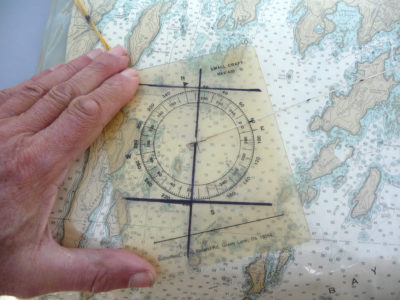
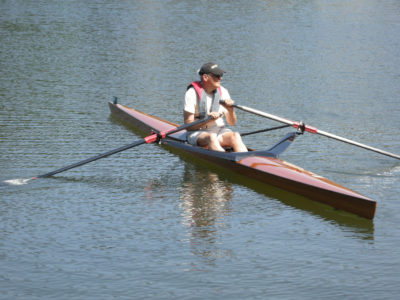
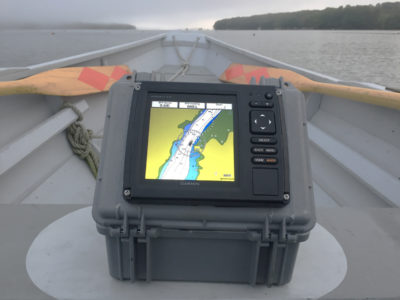
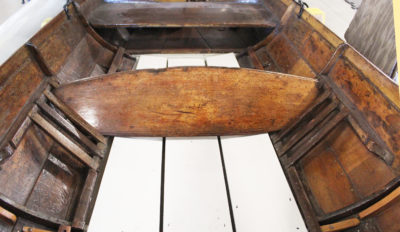
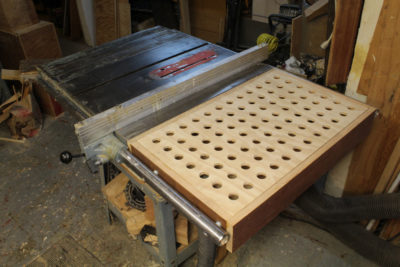
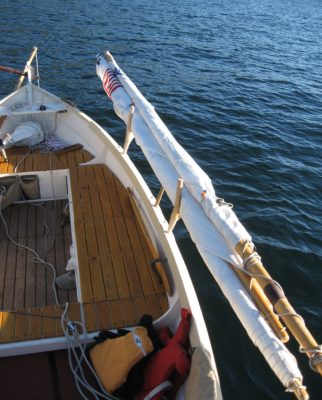
Good stuff. Short strokes and staying relaxed. With open-topped oarlocks it is sometimes helpful to put a little pitch into the oar blade, but only enough to keep the blade in place, not dig way down. I also like to play with timing. Going up wind or with wind off the bow, I try to avoid a hard pull when the bow of the boat is pitching down. Downwind let the wave run under you and pull hard when the stern lifts a little; you may start surfing. Angling into the wind to go sideways works really well, just as it does in current, where it is called ferrying. Sometimes playing with the blade pitch helps, as long as you don’t dig in too deeply.
Phil Bolger says the same thing about rowing in rough water, specifically, against a head sea: Use a short, quick stroke. This was confirmed for me one day while rowing a Bolger light dory in company with a Row Cat. It was probably blowing about 15 knots. I was able to stay with the Row Cat over some distance without working particularly hard. I adopt the same short, quick stroke when paddling a kayak (Pygmy Coho) in rough conditions. I think another reason this works better is that you have a blade in the water almost constantly, with very little energy and time wasted in waving oars/paddles in the air. Keeps steady pressure on the boat instead of intermittent pressure. It’s not really rowing/paddling harder, but rather with a quickened cadence. I do wonder whether the sliding seat is really an advantage in those conditions. Of course, with the kayak there is little concern about swamping from beam seas, though you do have to learn how to deal with cresting waves that might happen to break on you.
Great advice to an often ignored topic. I would add one possible source of comfort/competence. In calm conditions with folks around, work on a self-rescue drill where you fall out of the boat (on purpose) and get back in. Depending on the boat, some techniques might have to be devised. Actually learning to do this life-saving skill will allow you to relax much more in the boat in many conditions.
Very helpful advice! Two additional things I was taught many years ago for rowing in rough water and wind: feathering the blades of the oars to “slice” through the air and water and using a “Fisherman’s Row,” i.e., one oar at a time, to keep one blade in the water at all times.
Another technique I use in windy conditions and traveling with or against the wind is to shift rowing stations in my 14′ Whitehall. Rowing upwind I sit toward the bow, lifting the stern and creating a weathervane effect that keeps the stern parallel to the breeze. Downwind I sit sternward.
One interesting thing is feathering. I find that feathering is often a waste of energy, especially in rough stuff, unless I am dead upwind. I find the stroke is too short to really feather, my forearms wear out, and that the rough water does breaks up the wind such that the windage is not too problematic. It also helped that I used oars with long, skinny blades for rowing my Drake 17 (I wish I hadn’t sold her).
I feather the oars virtually all the time. The handles on the oars are cone shaped, with the end of the handle about 1 3/8″ and loom end of the handle 1″ in diameter. Feathering just requires ‘rolling’ my fingers up at the third joint and keeping my wrists almost straight. No strain on the forearm or wrist.
Another reason to keep the stroke short and quick, in addition to what was described in previous posts, is because the amount of glide between strokes is reduced in anything but tail wind. If you use a long, powerful stroke against the wind, the boat slows down between strokes and then you have to accelerate it. On every stroke. Short strokes help to keep the boat moving at a more constant speed.
The incident this piece is written around reminds so much of getting caught out kayaking in the vicinity of Kingcome Inlet some years ago. While wrestling with the initial panic, I realized relaxation was key and that fighting would not get the job done. The mechanics became apparent. It was a transcendent moment. And it is so easy to forget. The lessons have carried through to some intense rowing situations.
I use spoons of moderate width on my 16 footer, and I find myself feathering more often, certainly when headwinds pick up, and even in tranquil situations I sometimes appreciate the decreased vertical movement allowed by the feather. I can imagine narrower blades may handle rather differently.